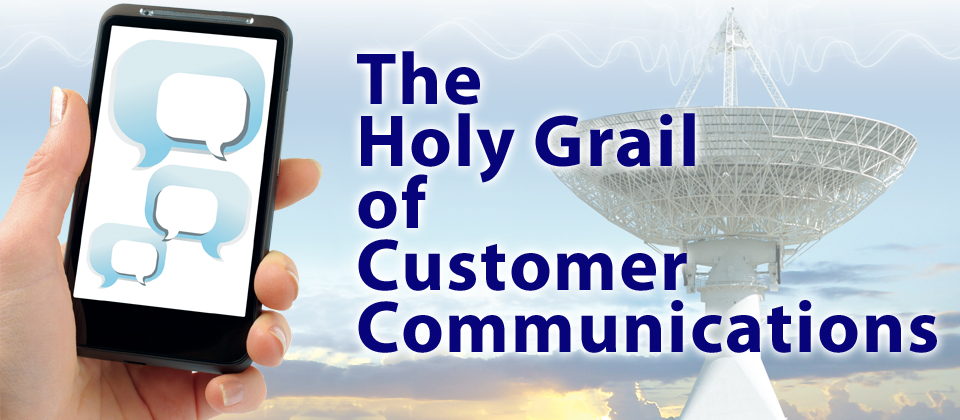
Text messaging takes convenience and service to a whole new level
By: By Richard Rutigliano, PriMedia Inc.
Communications is fundamental to any relationship, including the one between a local company and each of its customers. A company that can maintain helpful, two-way dialog with customers around the clock has an enormous advantage over a competitor that rarely makes contact and expects customers to make a phone call to request service.
The communication tool of preference for most consumers today is the one they carry with them everywhere at all times: the mobile phone. If you could reach customers regularly via text messaging and get them to text you back, you’d achieve the Holy Grail of customer communications.
Many large companies are already engaging customers by text, and now companies of any size can do the same. The technology you need to maintain sophisticated text-based communications is here today. Once you learn to use it effectively, you can provide customers a level of convenience unlike anything before. You’ll also be able to communicate with them directly and quickly, knowing they will receive your messages and be able to respond immediately.
Like No Other Medium
Texting to mobile phones offers significant advantages over other communications mediums. Most importantly, consumers are glued to their phones like no other device. Mobile phones, especially smartphones like the iPhone and Android devices, are compelling tools that users just can’t seem to put down.
TSG Global Inc. has compiled some interesting statistics that demonstrate the consumers’ powerful embrace of mobile phone texting:
- 80 percent of cell phone owners use text messaging
- 95 percent of text messages received are opened and read within minutes
- 75 percent of U.S. mobile subscribers send text messages; 49 percent download apps; and 49 percent use Internet browsers on their phone
- People who text-message send or receive an average of 35 messages a day.
Companies across the economic spectrum have noticed consumers’ preference for mobile communications and are adjusting their marketing accordingly. Forrester Research reports that spending on mobile marketing increased from $1.7 billion in 2011 to $2.7 billion in 2012. By 2016, companies are expected to spend a combined $8.2 billion on mobile marketing, compared to $7.4 billion on social media and e-mail marketing combined.
Forrester also polled companies on the expected effectiveness of various marketing strategies over the next three years. Fifty-one percent of respondents said they expected mobile marketing to be more effective. This compares favorably to display advertising (35 percent), television (21 percent), outdoor (15 percent), and radio (10 percent).
Hang Your Hat On It
The convenience of text messaging is so powerful that it makes sense to not only incorporate text communications but to place it front and center in your marketing. By emphasizing the convenience of mobile phone communications, you can shift the focus away from problematic issues like price and onto your suitability as a business partner.
As customers enter texting relationships with you, you’ll be able to put offers in front of them confident that they will be seen and read – probably within minutes. Compare that immense selling power to the effectiveness of other available mediums. Social media is great for building your image and personalizing customer relationships but the reach is limited, and focusing too much on sales can cost you followers. E-mail marketing is a great medium for extending special offers, but the open rate doesn’t approach that of text messaging. Newsletters offer excellent opportunities for relationship building, customer education and extending special offers, but they lack the instant interactivity of text messaging.
Text messaging is just one of several effective mediums available today, but it’s easy to imagine a future in which it is the dominant channel for all customer communications. As such, it makes sense to jump in now and try to become the most text-friendly provider in your market.
Strike the Right Balance
Text-based communication with customers is uniquely powerful because of the customers’ tight “relationships” with their mobile phones. With that power comes responsibility – to treat your texting privileges responsibly and avoid engendering customer resentment. Were a customer to start thinking that you sought access to their mobile phone just to spam them with sales pitches, your advantage would be lost.
It’s one of those (many) instances where it really pays to think like a customer and imagine how you would like the texting relationship to unfold. First, be certain that you are offering real value by enhancing their convenience and sending texts that they’ll be grateful to receive.
That will be easy if your company uses an advanced back-end computing system, because you can build direct links between text and back-end. You can enable customers to pay bills by text with a simple one-character response to your text. You can automatically notify them of upcoming appointments or enable them to schedule their next visit. Once you are delivering welcome services like those, customers will be more likely to tolerate occasional marketing messages.
To optimize your text communications, you’ll need a mobile website so customers can view links and interact with you instantly through their mobile phone browsers. Creating a mobile site that is based on your regular site is a fairly simple step that companies should be taking anyway to accommodate customers and prospects who like to search the Internet on their phones.
Know the Rules
As I mentioned above, text messaging takes you into the regulated public airwaves and exposes you to laws such as Telephone Consumer Protection Act. It’s not as intimidating as it sounds, but you need to heed the rules. As long as you opt customers in, disclose your intentions clearly and document customer consents, you’ll get off on the right foot.
Once you understand the rules, you can begin collecting mobile phone numbers. You’ll probably do a lot of communicating across different channels to announce the new service, so it makes sense to launch combination solicitation/promotion campaigns that emphasizes the company’s commitment to superior customer service.
Mobile phones are the most important, valued communication devices that consumers and business owners carry. Companies that master the medium can build a huge lead on the competition. Why not get started today?
Richard Rutigliano is President of PriMedia, Inc., a full-service Advertising/Integrated Marketing Communications/New Media firm with offices in New York, Boston, and Philadelphia.
















